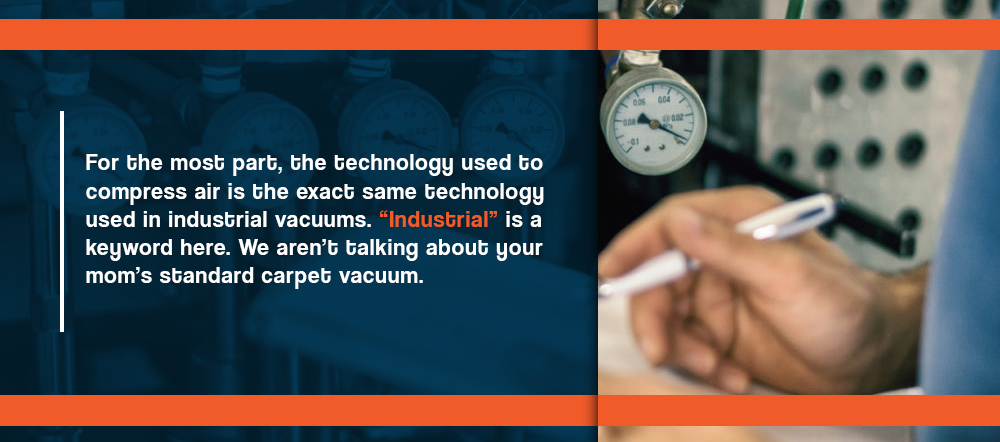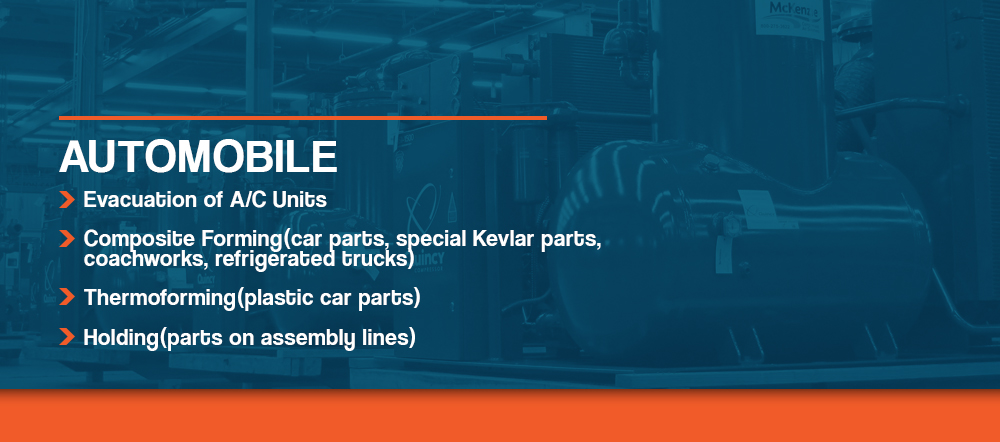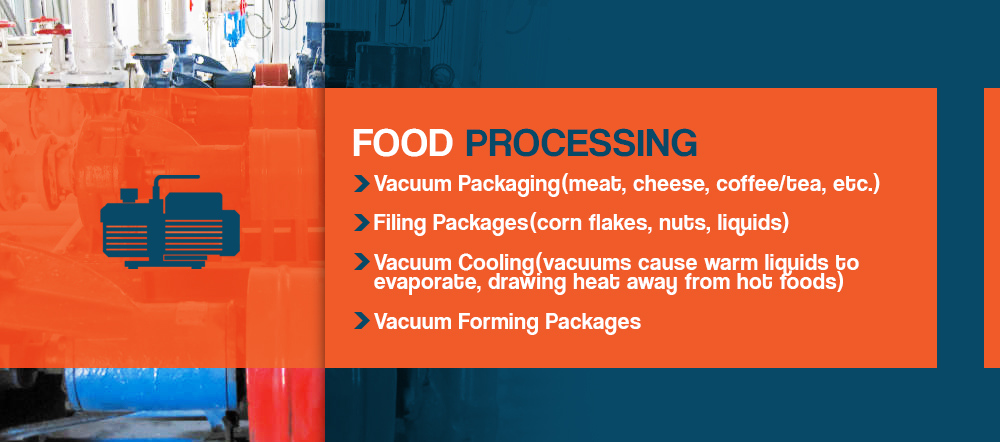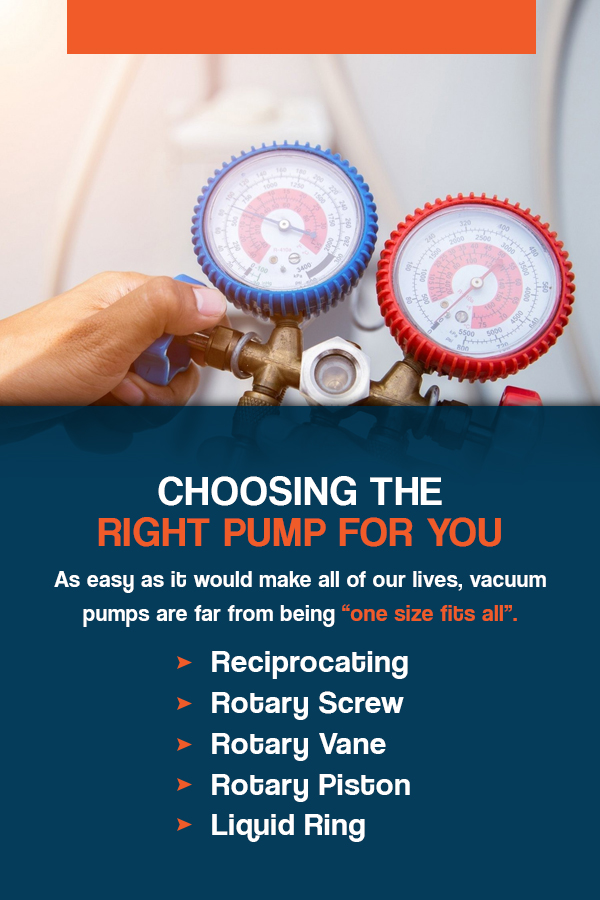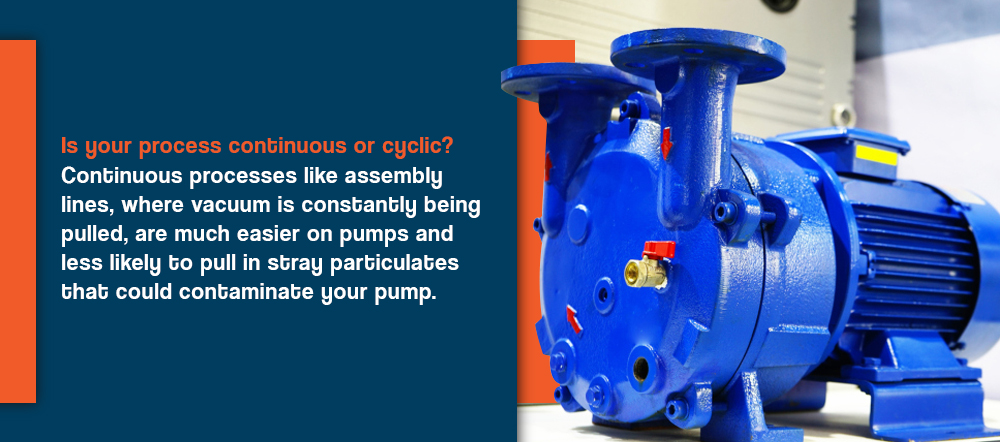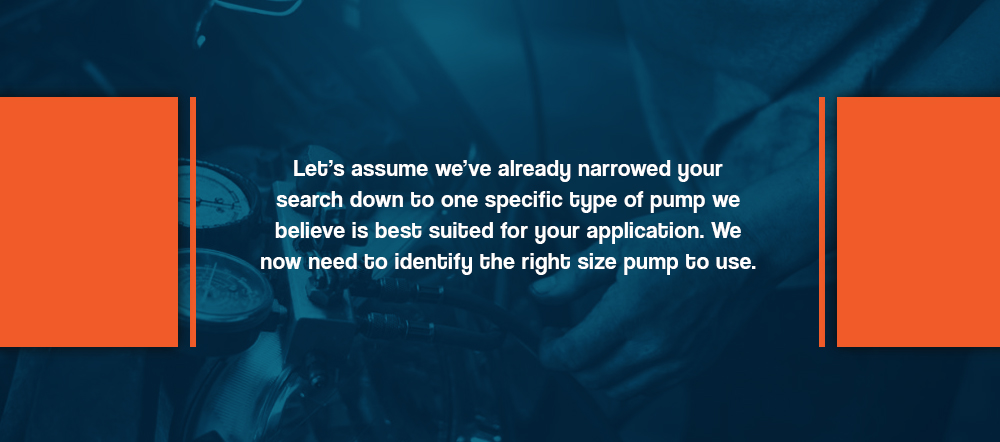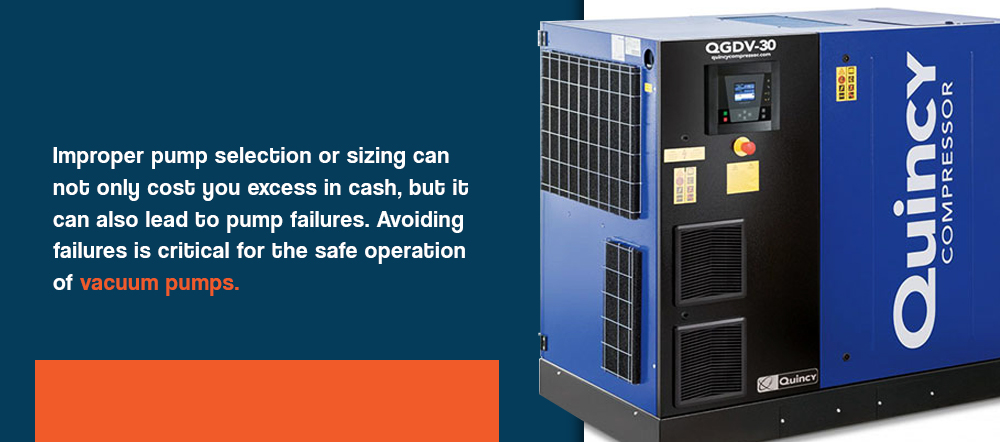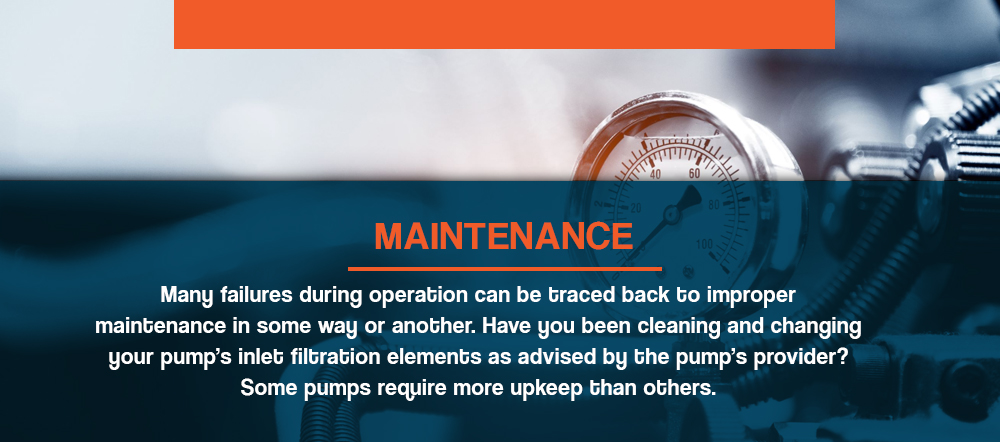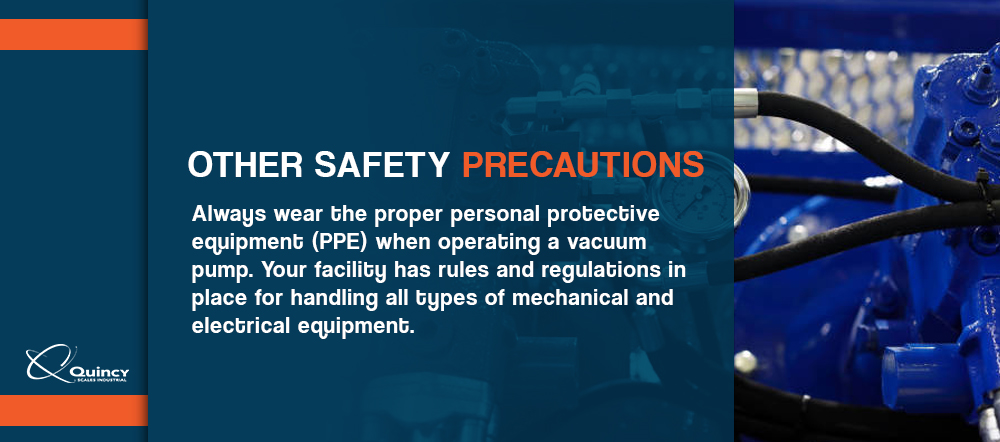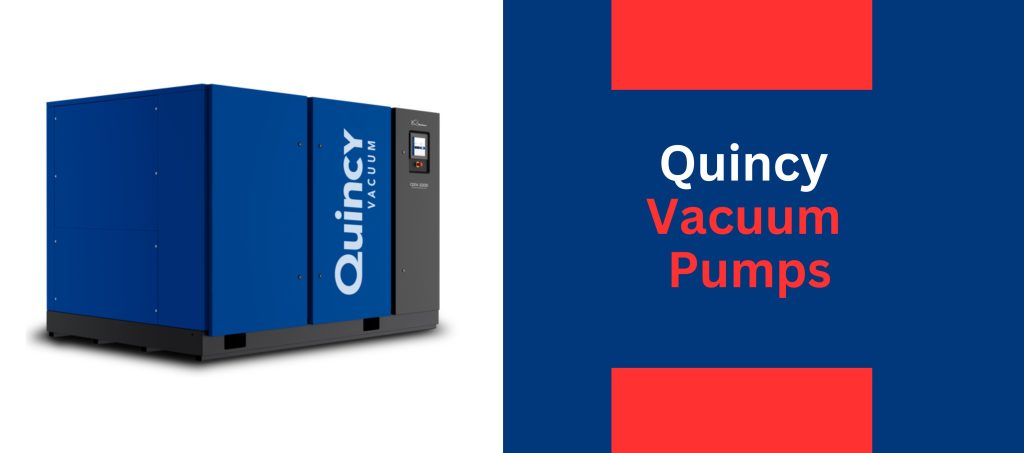
Here at Quincy, we are no strangers to the wide variety of industries that use compressed air. It’s an essential utility for many companies, vital for operation throughput and product quality. Many corporations considered to be “critical infrastructure” such as hospitals, pharmaceutical companies, and food companies depend heavily on Quincy compressed air.
We offer a variety of technologies to produce and deliver compressed air, each with advantages and disadvantages applicable to any given application. At this point, you may be asking, “What does this have to do with vacuum pumps?”
Vacuum vs Air Compression Technology “Same, but different…”
For the most part, the technology used in compressors is the same technology used in industrial vacuum pumps. “Industrial” is a keyword here, referring to vacuum pumps which operate in the “Rough Vacuum” range. Technologies include (but aren’t limited to): reciprocating piston, rotary screw (dry or oil flooded), rotary vane, claw/tooth, etc. In “Medium, High, and Ultra-High” vacuum ranges, vacuum pumps are much more differentiated than compressors, and include technologies like oil diffusion, turbo molecular, and cryogenic pumps. Quincy’s vacuum offering focuses on the industrial vacuum market, serving applications like pick-and-place, packaging, degassing, hold-down, and many more.
The use of a compressor is different from that of a vacuum pump in the sense that a compressor typically draws air from an open source (like the atmosphere) and discharges at higher pressure to a closed system, while vacuum pumps draw air (or some other gas) from a closed system and discharges to an open system (often the atmosphere). Both perform mechanical compression. Just at different spectrums of pressure.
Mechanically speaking, there are often subtle differences in the design/operation of a compressor vs. vacuum pump, including the rotating speeds, sealing designs, heat transfer capabilities, and power consumption. These differences are what necessitate machines dedicated to compression or vacuum, and why it’s generally not just a matter of “connecting to opposite ports”.
In our experience, users are much more familiar with the operating principles, applications and sizing of air compressors than vacuum pumps. Therefore, Quincy has a team of Vacuum Applications Engineers dedicated to guiding customers through the process of determining what’s best for their application and corporate initiatives.
In our article “Vacuum Pump Applications” we help outline just a few of the most common applications in various market segments, and what variables you should think about when considering a vacuum for your needs.
Vacuum Pump Applications
What do you think of when you hear the word “vacuum”? If you’re like many, a household carpet cleaner comes to mind, or maybe your garage wet/dry vac.
What if we told you that nearly all products are manufactured with the assistance of vacuum? The circuit board in your cell phone was created using vacuum. Many plastic products in your house were likely molded into the shape you see and use with vacuum. Do you still like the feel of a physical book or newspaper in your hands? The printing was made possible with the assistance of vacuum. Even most food and beverage products you consume each day were manufactured with vacuum playing a critical role.
Quincy vacuum pumps are used in various industries for a wide range of applications, making our jobs a never-ending lesson in how products are manufactured! Let’s take a look at vacuum applications commonly found in various market segments.
Aerospace/Naval
- Composite Forming: Production of helicopter parts, airplane parts, cabin sheathing, boat and submarine parts
- Thermoforming: Shaping of plastic parts
- Holding: Parts held in place during machining or assembly
- Altitude Simulation: Evacuating air to test the performance of equipment at various altitudes
- Leak Detection: Testing equipment seals for leaks that may occur in higher altitudes
Automobile
- Evacuation of A/C Units
- Composite Forming (car parts, special Kevlar parts, coachworks, refrigerated trucks)
- Thermoforming (plastic car parts)
- Holding (parts on assembly lines)
Chemical/Gas Petrochemical
- Degassing: Removing dissolved gasses and solvents from sensitive liquids
- Distillation: Separating liquids of different boiling points
- Evacuation: Removing air from and refilling gas bottles, removing air from pipes and tubes
- Filtration: Assist in the dewatering of slurry material
- Lab Testing: Bench scale distillation, drying and filtration
Food Processing
- Vacuum Packaging: Preservation by removing air from food packages (meat, cheese, coffee/tea, etc.)
- Filling Packages: Opening of containers and bags to fill products (chips, corn flakes, nuts, etc.)
- Bottle Filling: Filling beverage bottles (soda, beer, etc.)
- Vacuum Cooling: Evaporative cooling of foods (vegetables, lettuce, etc.)
- Evaporation: Removing residual moisture in one or multiple effects evaporators
Plastics
- Extruder Degassing: Removal of solvents and entrained air through barrel vents
- Calibration/Profiling: Shaping / cooling of extruded parts
- Thermoforming: Shaping of plastic parts from sheet
- Injection Molding: Shaping of plastic parts from extruder
- Solid State Polymerization: Improve pellet intrinsic viscosity before or after extrusion
- Conveying: Transfer of pellets from one place to another
General Industrial
- Woodworking: Fixture of materials on wood routing CNC machine
- Glass Blowing: Assist compressor with shaping of glass bottles
- Can Production: Belt transfer of cans, placement during washing / labeling
- Pick/Place: Transfer of products using vacuum or air ejectors
…and many more. Quincy Compressor is always working with customers who use vacuum in innovative ways to improve their throughput and/or product quality.
With this information in mind, chances are there’s a vacuum application in whatever industry you work in! Do you need a vacuum pump, or suspect vacuum could help with your operation? If so, there are many things to consider:
- What kind of pump technology is best for your application?
- What size pump is needed?
- What are the options to control the pump?
These questions are asked every day by people researching new and improved vacuum solutions. The truth is, you don’t need to know the answers to these questions because Quincy can help with those details. The important question to ask yourself is HOW vacuum influences YOUR operation and/or product. Some examples, and why they are important, are:
- Vacuum Level: This is the single most important characteristic when applying vacuum. Vacuum level often dictates product quality (firm fixation and accurate cuts on CNC routers, no bubbles/discoloration in extruder degassing, suitable preservation of meat packaging). A deeper vacuum isn’t always better. In fact, a deeper vacuum can be counterproductive in many applications (ie. tear filter paper, damage sensitive materials in pick-and-place). Furthermore…for the same load, a deeper vacuum generally results in larger pumps/systems and increased capital. We recommend spending some time determining what vacuum level can meet your product quality requirements.
- Product Throughput: In many applications, vacuum is used to evacuate a volume of air as part of an overall sequence of operations (food packaging chamber, volume from valve to cup in pick-and-place, sterilization chambers). The number of cycles that must be completed in a given period of time, and the time for things like venting, indexing, and loading the next product all dictate how much time is available to complete the required evacuation. In turn, the time available to complete the required evacuation drives the vacuum pump/system sizing. Be sure to understand your company’s current goals in terms of throughput (product per day, cycles per minute, etc.), and consider what those goals might look like in the future.
Many applications are a combination of evacuation (hogging) and then maintaining a specific vacuum level for a period of time (holding). The load associated with this holding condition can also be an important factor in sizing vacuum equipment. In some cases, like distillation or evaporation, that holding load is the result of the upstream equipment design and is very well defined. In other cases, the holding load is a function of air leakage, evaporation, or some other lesser-defined source. This is where the experience of our Vacuum Applications Engineers can help guide the technical discussion.
With an understanding of common vacuum applications and operational variables to reflect on, we’re now ready to start assessing vacuum technologies. In our article “Choosing The Right Pump for You” we outline the general advantages and disadvantages of various technologies and recommend questions to ask when the time comes for you to select and purchase your pump.
Choosing the Right Pump for You
In every buying decision, there are options to consider and value/costs to weigh. Selecting the appropriate vacuum technology for your application and your company is no different. There are few applications in vacuum in which everyone (users, governing bodies, and suppliers alike) agrees on a single technology as being the standard. Therefore, having a good fundamental knowledge of the advantages and disadvantages of common industrial vacuum technologies will help guide your research.
Below is a brief description of the operation, limitations, and advantages/disadvantages of many common industrial vacuum technologies.
Reciprocating
Principle of Operation: Crankshaft rotates a piston (or pistons) up and down, while a set of valves allow for the isolation and flow of process gas into suction and out of discharge pathways.
- Advantages: Well understood operating principle, large capacity ranges available on the market, easy to install
- Disadvantages: Frequent maintenance (large number of rotating parts subject to wear), lower efficiency, higher noise level and vibration, higher oil carryover
Rotary Screw (Oil-Flooded)
Principle of Operation: A matched set of screws with tight tolerances capture process gas at the inlet and convey the gas to the discharge, where compression against the atmosphere takes place. Oil is circulated throughout the machine to seal tolerances and absorb the heat of compression. Gas discharge is then passed through an oil mist separation system before exhausting to the atmosphere.
- Advantages: Long maintenance intervals straightforward maintenance activities, energy-efficient with good turn-down ratio, vibration-free, little oil exhaust, several cooling methods available (air, water-cooled, hybrid), complete “plug and play” vacuum system
- Disadvantages: Size and weight, particulate and liquid sensitive, not intended for pumping solvents (process gas comes in contact with sealing oil), higher initial cost vs. other oil-flooded solutions.
Rotary Screw (Dry)
Principle of Operation: A matched set of screws with tight tolerances capture process gas at the inlet and convey the gas to the discharge, where compression against the atmosphere takes place. Tolerances are so tight that each screw “flight” acts as a seal between vacuum and discharge. The pumping chamber is jacketed with cooling fluid circulated and cooled via cooling water and/or heat exchanger.
- Advantages: Dry solution means no sealing fluid coming in contact with the process gas, deep ultimate vacuum, mechanical sealing between the pumping chamber and gearbox, good turndown ratios and efficiencies
- Disadvantages: Maintenance in the field is often not practical, particulate and liquid sensitive, very high initial cost
Rotary Vane (Oil-Flooded)
Principle of Operation: A rotor is located eccentrically (off-set) within a pumping chamber, with vanes located in slots. As the rotor turns, centrifugal force slides the vanes against the inside walls of the pumping chamber. The vanes trap the volume of air at the suction, which is then compressed and exhausted into the discharge box. Sealing oil is injected throughout the pump to lubricate the vane contact and remove the heat of compression. Discharge gas is passed through a discharge box, where oil is separated. The oil is circulated through a filter and cooler before being reinjected.
- Advantages: Direct drive-low vibration, deep ultimate pressures, a wide range of pumping capacities available, air-cooled, low noise level, lower capital investment, low rotational speed leading to less wear
- Disadvantages: Particulate and water vapor sensitive, some have limitations for continuous duty usage at higher pressures, unable to handle water or liquid slugs frequent oil changes)
Rotary Piston
Principle of Operation: A piston is located eccentrically (off-set) within a pumping chamber. As the piston rotates past the suction port, gas is drawn into the pumping chamber. The process gas is compressed by the rotating piston (while the suction if valved closed) and exhausted through a discharge check valve. Oil lubricates the piston and the pumping chamber.
- Advantages: deep ultimate pressures, air and water-cooled versions, lower capital investment, rugged
- Disadvantages: Higher noise level and vibration, higher oil carryover, large oil volumes
Rotary Claw
Principle of Operation: Two claw shaped rotors are positioned within a pumping chamber and rotate in opposite directions. As the rotors pass the suction opening, they trap air between themselves and the outside walls of the pumping chamber. Air is eventually compressed via the matting claw geometries and exhausted into a discharge silencer.
- Advantages: Long maintenance intervals, straightforward maintenance activities, low rotational speed leading to less wear, dry solution means no sealing fluid coming in contact with the process gas, air-cooled
- Disadvantages: Limited ultimate vacuum (overheats if operating too deep), higher vibration level, higher noise levels, limited water vapor handling
Liquid Ring
Principle of Operation: An impeller is located eccentrically (off-set) within a pumping chamber which is filled with a sealed fluid (typically, water). As the rotor turns, centrifugal force pushes the water to the outside perimeter of the pumping chamber, creating “buckets”. As the impeller rotates past the suction port, gas is drawn into a “bucket”, compressed, and exhausted through the discharge port. A gas/liquid separator then removes water from the process gas.
- Advantages: Extremely large flowrates available, handles particulates and liquids well, little maintenance and straightforward maintenance activities, can be made from many materials of construction (including stainless steel, Hastelloy, etc.)
- Disadvantages: Water consumption and disposal, low energy efficiency, discharge saturated with liquid, performance subject to fluctuations in seal water temperature.
These advantages and disadvantages may help you start eliminating options based solely on things like utility availability and corporate initiatives. For example, if water is a costly utility in your area, you may want to eliminate liquid ring pumps from your consideration. If water is not a concern, but noise and vibration levels are, you may lean towards a liquid ring as a potential fit for your application.
Look at that! We’re already narrowing your search. Here are some other factors to consider when searching for the right pump technology for you…
Questions to Keep in Mind
Is your process continuous or cyclic?
Continuous processes where vacuum is maintained at a fixed level (or within a controlled range), are much easier on pumps. A cyclic process is one that involves repeated evacuation of a closed system from atmospheric pressure to a lower desired pressure. Cyclic processes operating with oil-sealed pumps can lead to excessive oil mist exhaust if too much time is spent at higher pressures (slight vacuum). Not only is this undesirable for the working area, but the reduction in oil over time can lead to mechanical complications within the pump. Applications like thermoforming, where hot plastic sheets are drawn into a mold one after the other, are examples of cyclic processes. It’s important to know which one applies to your process.
Are condensable vapors or liquids coming off the process?
As liquids are incompressible, introducing them in large quantities in a vacuum pump can cause failures (in some cases, irreparable and sudden). Process gases that may exist as vapors under vacuum conditions but as a liquid at atmospheric conditions may condense in a vacuum pump. With oil-sealed pumps, this condensate will affect the oil’s ability to adequately lubricate pump components. With a dry pump, condensable liquids will lead to oxidation and rusting. When we apply vacuum pumps on applications with the potential for liquid slugs or condensable vapors, countermeasures are employed to ensure our pump and your operator’s safety aren’t jeopardized.
Is there particulate coming off the process?
Many vacuum applications involve cutting materials, conveying bulk substances, or other applications that could result in particulate carryover to the vacuum pump/system. In these cases, it’s important to understand the general size and magnitude of the particulate, so effective countermeasures can be implemented. Installing a 50-micron inlet filter may catch large chunks (or the ill-placed socket wrench) but won’t do much for sawdust. Improper filtration leads to damaged pump components. Damaged pump components cause failures. Failures can lead to injury.
What are the ambient operating conditions?
Is this pump operating in a hot environment? With rotating equipment one of the most critical factors for stable operation is temperature. The temperature of the motor, bearings, elastomers, etc. A pump operating in a hot environment is at increased risk for failure (especially if it’s an air-cooled pump). At what elevation will the pump be used? The air at higher altitudes is less dense, meaning forced air used for cooling is less effective.
These are some of the many questions we ask in the pump selection process. Addressing these points during the quotation phase can help ensure the right technology (and variation thereof) is selected, ensuring years of smooth and stable operation.
Now that you’ve made sure to REALLY understand how vacuum supports your operation and read through the pros/cons of various pump technologies, it is now time to discuss a few important variables that will influence the size of the pump.
Vacuum Pump Sizing
Let’s assume we’ve already narrowed your search down to one specific type of pump we believe is best suited for your application. We now need to identify the right size pump to use. Here at Quincy we have performance curves for all of our pumps. These curves tell us the capacity each pump can push at various levels of vacuum.
When considering our QSV line of rotary screw pumps, for example, our larger sized QSV 1100 can push nearly four times the capacity that our smallest size QSV 205 can push at the exact same level of vacuum. For this reason, and various others, we wouldn’t want to install a QSV 1100 where a 205 would get the job done. An oversized pump draws more power and isn’t as efficient. We would only want to oversize a pump if the operation is rapidly growing to match some demand.
It’s always a good idea to consult professionals when sizing a vacuum pump. Most of the variables that determine the size pump required are difficult to measure. It’s easy to assume you need a higher level of vacuum suction for your operation because the current level isn’t sufficient. But what if there is a leak somewhere in your operation you aren’t aware of? Well, you just oversized your vacuum pump to compensate for a leak. Now your pump is drawing more power, you’re paying more for energy, and your boss is mad that you didn’t consult professionals. Or, for instance, let’s say you’re pumping down a relatively small process chamber.
You determine one of our smaller pumps will get the job done. But hold on, you didn’t consider all of the pipes connecting your pump to the process chamber. You didn’t consider the pressure drop occurring across these pipes or within your filtration elements and liquid separators. Well, my friend, you just undersized your pump. Now you’re guaranteed to spend more money trying to fix a problem that wouldn’t exist had you consulted a vacuum professional. Never hesitate to call us. We will make sure mistakes like this don’t happen. Our job is to save you from these headaches.
Vacuum Pump Failures/Safety
Improper pump selection or sizing can not only cost you excess in cash, but it can also lead to pump failures. Avoiding failures is critical for the safe operation of vacuum pumps. Not only do you want to protect your investment, but you also want to protect your workers most of all. Any time equipment fails, safety is a concern. The safest way to operate any vacuum pump is by first having the right pump operating. Most safety concerns can be avoided ahead of time in the selection and sizing process. However, after your pump is installed and operating, it is very important to maintain it. Proper maintenance is a must to continue avoiding failures, keeping your operators safe.
Maintenance
Many failures during operation can be traced back to improper maintenance in some way or another. Have you been cleaning and changing your pump’s inlet filtration elements as advised by the pump’s provider? Some pumps require more upkeep than others. If your pump’s filtration isn’t being kept up according to our advised maintenance schedule, solid particulates can likely make their way inside your pump, damaging various sensitive components depending on your pump type.
Many companies put the responsibility on machine operators to clean and replace inlet filters without the assistance of qualified maintenance personnel. If this is not done correctly, a particulate bypass occurs and may degrade your pump. Inlet filtration elements that handle solid particulates are not rated to handle liquids or vapors introduced to the pump by your process.
Process liquids require a different type of separator to assure liquids don’t make their way into your pump. Minor liquid damage can cause couplings to break, contaminate the oil, and cause rust or corrosion of internal pump components. Moderate liquid damage can cause electrical drive motor failures due to excessive loading, broken vanes in rotary vane pumps, damage to exhaust valves, deformed internal pump components from hydraulic pressure, bearing failure from the contaminated lubricant, or sludge buildup. Severe water damage can permanently destroy the pumping module if it attempts to compress a liquid.
Process vapors or gasses are handled with condensers or cold traps. Different types of gasses or vapors require different precautionary measures. For example, corrosive process gasses may require filters containing materials such as polypropylene, fiberglass, or stainless-steel mesh to eliminate or reduce chemical attack. Water vapors may not be an issue if operating a water-sealed vacuum pump. If the vacuum pump is oil-sealed, we certainly need to consider the damages water vapor can cause.
Even with proper inlet filtration practices, filtration at the exhaust may also be a necessary safety measure to take depending on the process and environment. With work areas becoming cleaner and regulations becoming more stringent regarding airborne oil contamination, there is heightened awareness of contaminants in vacuum pump discharge air. This awareness has resulted in an effort to not only keep the air clean and free of oil smoke but also to keep production machinery, factory walls, ceilings and roofs all clear of oil contamination.
The bottom line is that oil sealed vacuum pumps can discharge oil even when supplied with quality OEM separation packages. Your pump likely already possesses a separation system, after the pump itself, responsible for removing oil from the exhaust air through various methods. If other equipment operating near your pump’s exhaust is sensitive to oil contamination, excess exhaust filtration may be necessary.
Other Safety Precautions
Always wear the proper personal protective equipment (PPE) when operating a vacuum pump. Your facility has rules and regulations in place for handling all types of mechanical and electrical equipment. Vacuum pumps possess electrical and moving mechanical components that can cause serious injury without the proper PPE. You and your operators should always consult your facility’s PPE regulations. Items likely required or prohibited by your facility to safely operate this equipment may include…
- Steel Toe Boots
- Protective Eyewear
- Best 4500 Gloves
- Hearing Protection
- Exclusion of watches, rings, long hair, or other jewelry
- Shock/Flash hazard protection
It’s important to remember these are only recommendations. Because safety regulations vary from facility to facility, consulting your own facility’s rules is of utmost importance.
With the information provided here, you are not only prepared to begin the vacuum pump selection and sizing process, you are equipped with the knowledge to begin practicing safe vacuum pump operation. Remember, no matter your level of vacuum pump awareness, do not forget to consult professionals. Here at Quincy, we want to solve these problems for you, providing guidance in selecting the proper pump for you.
At Quincy Compressor, we sell a range of reciprocating and rotary screw air compressors in addition to vacuum pumps. To learn more about our inventory, browse our site and check out our helpful air compressor resources.


